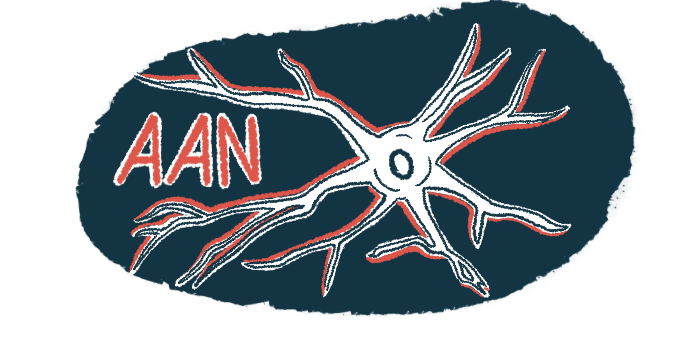AAN2023: ANX005 stabilizes functional capacity in Phase 2a trial
A Phase 2/3 trial to test the therapy in early-stage Huntington's is planned

Note: This story was updated May 16, 2023, to correct the duration of ANX005 infusions. Only the first loading dose of the therapy is given for 21 hours, with subsequent doses having a duration of four to five hours.
The experimental therapy ANX005 safely leads to stabilization or improvements in functional capacity for early Huntington’s disease patients or those at risk for the neurodegenerative disease, according to final data from a Phase 2a clinical trial.
The Annexon Biosciences’ therapy may benefit patients with high activation of the complement system, an immune pathway implicated in neurodegeneration, results showed.
Given these positive results, a Phase 2/3 trial to evaluate ANX005 in patients with early-stage Huntington’s is planned for later this year, according to Rajeev Kumar, MD, one of the trial’s investigators and the medical director of the Rocky Mountain Movement Disorders Center, Colorado.
Kumar presented the findings at last month’s American Academy of Neurology annual meeting in a talk titled “A Phase 2 Open-Label Study to Assess the Safety, Tolerability, Pharmacokinetics, and Pharmacodynamics of Intravenous ANX005 in Patients with, or at Risk of, Manifest Huntington’s Disease (HD).”
ANX005 is an antibody designed to suppress complement component 1q (C1q), a protein that initiates activation of the complement cascade. It was designed “in response to the idea that there’s significant neuroinflammation going on in many neurodegenerative disorders” such as Huntington’s, Kumar said.
During brain development, C1q helps regulate the elimination of synapses — the junctions between nerve cells through which they communicate — that are less active. In neurodegenerative diseases, it’s thought that abnormal C1q accumulation at synapses drives complement activation, leading to chronic neuroinflammation and synapse loss.
By blocking C1q from accumulating, ANX005 should prevent synaptic loss and slow neurodegeneration in several diseases, including Huntington’s, as shown in a mouse model of the disease.
The open-label Phase 2a trial, called ANX005-HD-01 (NCT04514367), assessed the safety, tolerability, pharmacological properties, and exploratory effectiveness of ANX005 among 25 adults with an early form of Huntington’s and three people at risk for the disease.
Clinical function remains stable
The first patient was dosed in November 2020. The participants’ mean age was 49.7 and 43% of them women. These demographics were “very similar” to previous natural history studies, Kumar noted.
All participants were given a 21-hour loading dose of ANX005 as an into-the-vein infusion. A second five-hour loading dose was given five days later. Subsequent four-to-five hour infusions were given every two weeks for 22 weeks (about five months), followed by an additional three-month off-treatment monitoring period.
Immediately after the initial loading dose, participants had complete depletion of C1q in the blood and cerebrospinal fluid (CSF) — which surrounds the brain and spinal cord — that was maintained throughout the treatment period. These levels gradually increased during the off-treatment.
Efficacy measures included changes in the composite Unified Huntington’s Disease Rating Scale (cUHDRS) and total functional capacity (TFC), both of which assess overall functional capacity, with high scores indicating better function.
Results showed clinical function by either scale remained relatively stable over the nine-month study, consistent with a previous interim analysis. Such stability is “slightly better than the expected declines seen by our natural history [studies],” Kumar said.
Investigators also assessed whether the subset of patients with high complement system activity at the study’s start (baseline) — reflected by a high complement C4a to C4 ratio (C4a/C4) — may be more likely to respond to the therapy.
Indeed, a greater proportion of those with a C4a/C4 above the median at baseline saw increases in cUHDRS scores after six months relative to those with a ratio below the median (75% vs. 36%).
Also, at the end of treatment, the increases in cUHDRS scores seen in the subgroup with a high C4a/C4 ratio were significantly greater than those in the low C4a/C4 ratio subgroup.
“In terms of TFC, there was a trend toward improvement that did not reach statistical significance,” Kumar said.
‘Promising’ finding with biomarkers
Blood and CSF levels of neurofilament light chain, a biomarker of nerve cell damage, remained stable throughout the study. That finding is “quite promising,” given that recent trials of other experimental Huntington’s therapies have seen an increase in this biomarker with treatment, Kumar noted.
A number of other biomarkers were assessed. In particular, YKL-40, a marker of neuroinflammation that’s increased in the CSF of Huntington’s patients, tended to decrease with ANX-005 in the high-ratio subgroup. The subgroup difference didn’t reach statistical significance, however.
Regarding safety, all the participants saw infusion-related reactions, usually a rash, with the first infusion. These were responsive to appropriate treatment and were resolved by the end the infusion in nearly all cases.
The treatment was otherwise generally well tolerated and no serious infections or deaths were reported during the study.
Five people discontinued treatment, three due to autoimmune-like side effects potentially linked to ANX005 that resolved after treatment was stopped. All three of those patients had elevated blood levels of antinuclear antibodies (ANAs), which is associated with autoimmune disease.
“As we go forward to develop this drug, enhanced ANA … screening will be necessary and we’ll have to have a way to carefully monitor for the development of these kind of adverse effects,” said Kumar, who noted the findings underscore ANX005 showed target engagement, stabilized disease progression over nine months, and resulted in “rapid clinical improvement in those with high [baseline] complement activity that was maintained.”
“This may represent the first time we’re able to show that relative blocking of complement activity results in protection of synapses in Huntington’s disease,” Kumar said.







